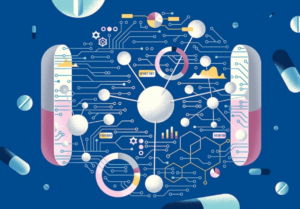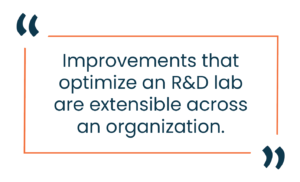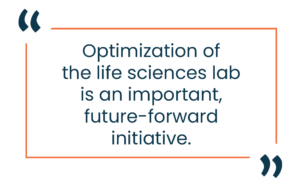 Labs are resetting the trajectory for drug development: reducing timelines from years to months; decreasing costs from billions to millions; and gaining an advantage by delivering drugs to market in months rather than decades.
Labs are resetting the trajectory for drug development: reducing timelines from years to months; decreasing costs from billions to millions; and gaining an advantage by delivering drugs to market in months rather than decades.
This value combination is a compelling case for investment in digital capability and organizational transformation.
A 100x or 1000x advance in lab efficiency is an achievement that is within reach for R&D labs, and the time has never been more important than now to grasp opportunities for change. The race to market is driving organizations toward higher efficiencies, yet scientific iteration is constrained by access to critical data. Without scalable solutions for connecting data to analytical systems, lab performance will lag.
Our experience suggests that R&D lab performance is challenged by a traditional scope for evolving the lab that limits change to small work groups and restrains new technologies within specialized areas of science.
Our vision is to empower scientists and engineers to gain and retain the skills necessary to accelerate their science in an R&D environment that is optimized for scientific creativity and productivity.
One of the best examples of an optimized R&D environment is a lab that harnesses new technologies to connect with data, automate measurements and data ingestion, and applies AI & machine learning techniques to run volumes of iterative tests, capturing results as analytics-ready data. Scientists in this type of optimal environment are working within their best scientific capacities and advancing science to help the organization adapt and realize its full business potential.
In our observations of the life sciences market, we have seen significant successes that are attributed to focused efforts that transform R&D holistically as new digital technologies are introduced, and scientific staff develop the skills to work nimbly and autonomously. In one example of MIT using AI to discover a new antibiotic, a team of scientists made a ground-breaking discovery-a new molecule-that had an inhibiting effect on E. Coli bacteria. The interactive process was simplified to run computations at an unprecedented new rate that led to life-saving discovery.
 Improvements that optimize an R&D lab are extensible across an organization. In the article “Ten battlegrounds for digital and analytics in life sciences” McKinsey takes a broad organizational view and outlines 10 ‘battlegrounds’ that represent significant opportunities for value creation within life sciences. McKinsey argues that digital success comes from picking your battles and focusing on the system as a whole.
Improvements that optimize an R&D lab are extensible across an organization. In the article “Ten battlegrounds for digital and analytics in life sciences” McKinsey takes a broad organizational view and outlines 10 ‘battlegrounds’ that represent significant opportunities for value creation within life sciences. McKinsey argues that digital success comes from picking your battles and focusing on the system as a whole.
Each battleground is “… an area of the business system where it is possible to deliver value at scale through a “platform solution,” whereby specific data sets, data and analytics platforms, analytical models, and digital experiences for customers and end-users are brought to bear upon a cluster of closely related digital and analytics use cases.”
But, what “platform solution” is the right solution to provide the foundation for change? Rather, what partner can facilitate lasting change?
In our view, there are three central building blocks that uphold the foundation, and it takes a very particular partner to bring about a successful transformation. To frame the top 3 values in selecting a partner, we highlight the following:
- Process-oriented partnership
- Technology leadership
- People-centric model
Scaling digital innovation across the organization requires taking the long view, with leadership that is committed to providing governance and sponsoring digital innovation initiatives. Chris Llewelln, Senior Partner at McKinsey in London, states, “Without such sponsorship and a narrative that makes clear the need for change, most business leaders will stay focused on short-term profit and loss targets, lacking any incentive to do things differently.”
These are the incremental advances from digital technologies that the organization knows how to scale.
A digital strategy must include objectives that encourage the R&D lab to pursue possibilities, not just incremental advances. “It cannot be assumed that if investments in people, data, and technology are made, value will follow. A business case must be made at the outset, then reviewed at least quarterly to ensure the link to value holds firm.” (Llewelln)
Making a convincing business case for possibilities through lab R&D is much more challenging than one for incremental advances, which typically offer line of sight to value in the near-term, such as the next two quarters. 
Optimization of the life sciences lab is an important, future-forward initiative. It is critical that science-driven organizations be able to exploit these advances as they become available, whether in their enabling ‘platform’ or the advanced software solutions that will run on it.
Delivering early business value through initiatives targeting digital innovation is critical. Without an early win, teams and organizations can lose interest, and leadership moves on to focus on other projects, tools, and initiatives that provide clear value. These projects, tools and initiatives often provide only incremental improvements, measured quarterly, whilst the possibilities enabled by advanced digital capabilities are missed.
The R&D labs of the life sciences sector are preparing to embrace change. At Enthought, we are here to support companies with the highest empowering solutions to advance their science and technology, and accelerate their path to market success. We are ready to build out the next solution to scale and redirect the trajectory of scientific pursuits.
Ultimately our work begins in the R&D lab by equipping scientists with the power of rapidly advancing scientific software tools and techniques. For more information on the Enthought approach to transforming the R&D lab, Contact Us and we will be happy to respond.
Related Content
コンカレント材料設計:AIで実現する次世代アプローチ
AIの高度最適化、生成AI、エージェント型AIの活用により、材料と製品を同時に設計・最適化するコンカレント材料設計についてご紹介します。開発スピードと自由度が飛躍的に向上させることで、性能向上や市場投入までの期間短縮、競争優位性の確立が可能となります。
「収益性の壁」を超える:AIの活用で機能性材料開発を戦略から再構築
スペシャルティケミカルおよび素材産業は、コモディティ化と価格競争の激化により、従来の差別化戦略では持続的成長が難しくなっています。こうした中、AIやマテリアルズインフォマティクス(MI)などの先端技術が、R&D戦略の再構築と成長再加速への有力な打ち手として注目されています。
研究開発組織の変革を成功させるためのパートナー選び
現在の競争が激しいR&D環境において、適切なテクノロジーパートナーを選ぶことは、組織にとって最も重要な意思決定の1つです。理想的なパートナーとは、単なるツールベンダーやシステムインテグレーターではなく、生産性を向上させ、イノベーションを加速し、競争力を引き出す解決策を提供する科学的な専門知識と戦略的な洞察を兼ね備えた「変革の同志」です。
「AIスーパー・モデル」が材料研究開発を革新する
近年、計算能力と人工知能の進化により、材料科学や化学の研究・製品開発に変革がもたらされています。エンソートは常に最先端のツールを探求しており、研究開発の新たなステージに引き上げる可能性を持つマテリアルズインフォマティクス(MI)分野での新技術を注視しています。
デジタルトランスフォーメーション vs. デジタルエンハンスメント: 研究開発における技術イニシアティブのフレームワーク
生成AIの登場により、研究開発の方法が革新され、前例のない速さで新しい科学的発見が生まれる時代が到来しました。研究開発におけるデジタル技術の導入は、競争力を向上させることが証明されており、企業が従来のシステムやプロセスに固執することはリスクとなります。デジタルトランスフォーメーションは、科学主導の企業にとってもはや避けられない取り組みです。
産業用の材料と化学研究開発におけるLLMの活用
大規模言語モデル(LLM)は、すべての材料および化学研究開発組織の技術ソリューションセットに含むべき魅力的なツールであり、変革をもたらす可能性を秘めています。
科学研究開発における効率の重要性
今日、新しい発見や技術が生まれるスピードは驚くほど速くなっており、市場での独占期間が大幅に短縮されています。企業は互いに競争するだけでなく、時間との戦いにも直面しており、新しいイノベーションを最初に発見し、特許を取得し、市場に出すためにしのぎを削っています。
R&D イノベーションサミット2024「研究開発におけるAIの大規模活用に向けて – デジタル環境で勝ち残る研究開発組織への変革」開催レポート
去る2024年5月30日に、近年注目のAIの大規模活用をテーマに、エンソート主催のプライベートイベントがミッドタウン日比谷6FのBASE Qで開催されました。
科学研究開発における小規模データの最大活用
多くの伝統的なイノベーション主導の組織では、科学データは特定の短期的な研究質問に答えるために生成され、その後は知的財産を保護するためにアーカイブされます。しかし、将来的にデータを再利用して他の関連する質問に活用することにはあまり注意が払われません。